With rivers and mountains the 2nd state, Virginia, has a diverse range of environments to attract and to house our fine feathered friends. Today we are going to discuss a few of these Avian wonders and let you know where to find them, how to attract them, and what markings are distinctive to the species that you are most likely to find in the Commonwealth. Let’s talk about the popular backyard birds of Pennsylvania!
3 Categories – 432 Birds
432 birds is a lot of birds to go through and so to simplify things we’ve picked an assortment of birds and we’re dividing up our listings into seasons, so that you have information as to what the bird looks like, what it likes to eat, and WHEN to look for it. We’ll use the following seasonal divisions and if you are lucky we might throw in some bonus birds after that. You’ll just have to stay with us and see! We’re dividing up the seasons as follows:
- Year-round Resident birds
- Birds of Spring, Summer, and Early Fall
- Fall and Winter Birds
Pennsylvania’s Year-Round Resident Birds
Some birds are dedicated locals just like you! We’ve compiled a few examples that you can look for and potentially find at any time of the year in the great state of Pennsylvania. With a little patience (or some sneaky feeder-baiting) you might just catch a glimpse of one or more of the following birds:
- White-throated Sparrow
- Tufted Titmouse
- American Robin
- Downy Woodpecker
- Mourning Dove
White-throated Sparrow – Zonotrichia albicollis
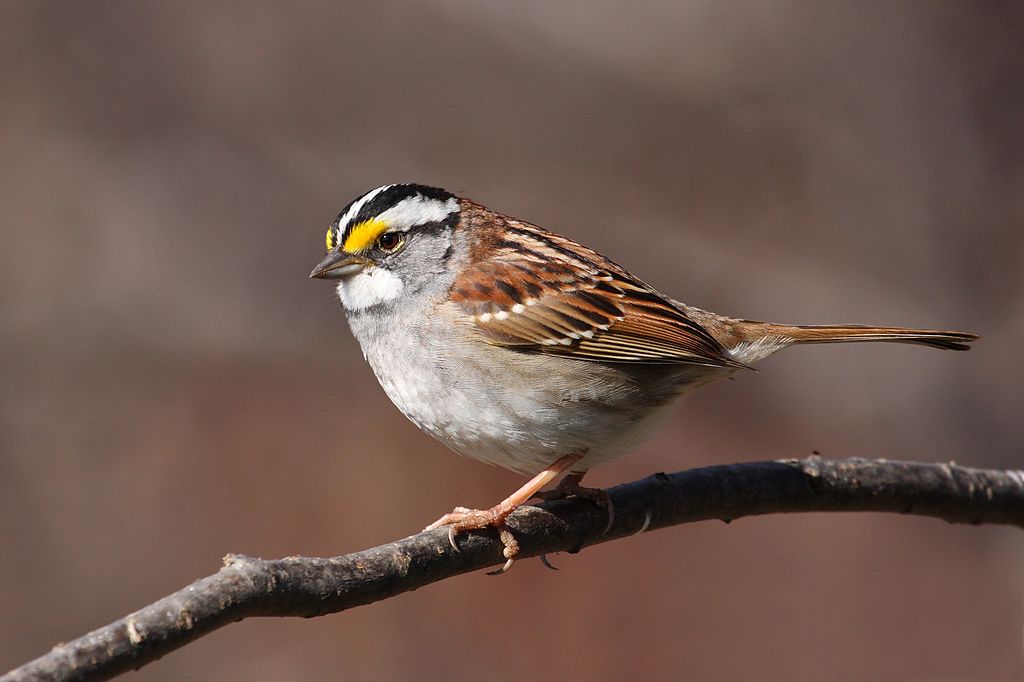
Coloration and Markings: The White-throated Sparrow is mostly brown in it’s wings and tail, although there is some white edging at the shoulders and some black edging throughout the plumage. The breast and underbelly are white but flanked with gray. Facially, this bird has a gray face with a white chin and a very distinctive white ‘eyebrow’, which terminates close to the short, silver bill with a yellow mark. At the cap, this bird has ‘skunk’ markings, with the top of the head being black and bisected with a visible white stripe down the center. One variety of this Swallow, referred to as ‘Tan Striped’, bears the same markings but in brown, rather than black.
Size: This bird measures in at 6.3 – 7.1 inches in length with a wingspan of 7.9 to 9.1 inches.
Habitat: These birds like to hang out at the forest’s edge, near water, or in areas of dense vegetation such as thickets or shrubs.
Diet: Black Oil sunflower seeds and millet will work but we recommend that you scatter some at the base of the feeder, too. These birds like to forage on the ground.
Tufted Titmouse – Baeolophus bicolor
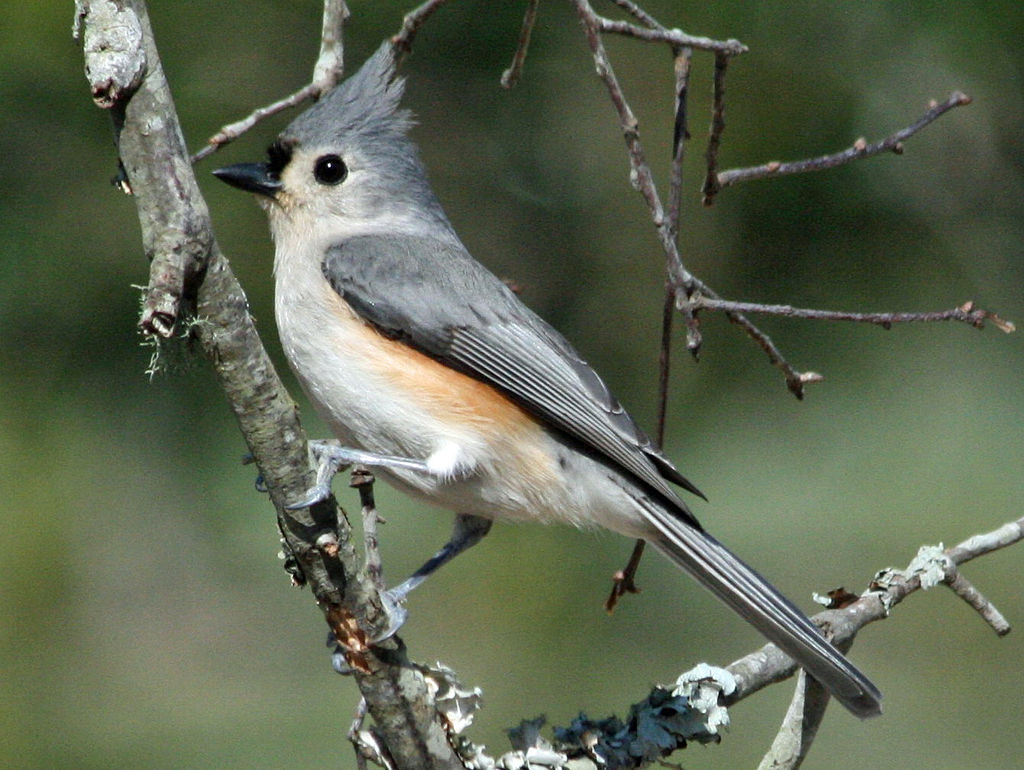
Coloration and Markings: As the Latin names suggests, this is chiefly a bicolor bird. The ings and tail of the Tufted Titmouse are blue and gray while the breast and underbelly are pale white… with a small exception. The flanks of this bird will have a touch of peach. Facially, the chin and cheek are white and the white extends to outline the eye, but beyond this on the upper face of the bird it is the same silvery-blue as the body. This bird has a small, slightly curved black bill and a black mark above said bill completes the identification.
Size: This bird 5.5 – 6.3 inches from tip to tail and has an average wingspan of 7.9 to 10.2 inches.
Habitat: The Tufted Titmouse loves deciduous forests but also ventures into parks and backyards without hesitation. Watch for them and be sure to leave out some snacks, this is a pretty bird and you don’t want to miss out!
Diet: Suet, peanuts, and Black Oil sunflower seeds are a winning combination for attracting and keeping this bird as a visitor.
American Robin – Turdus migratorius
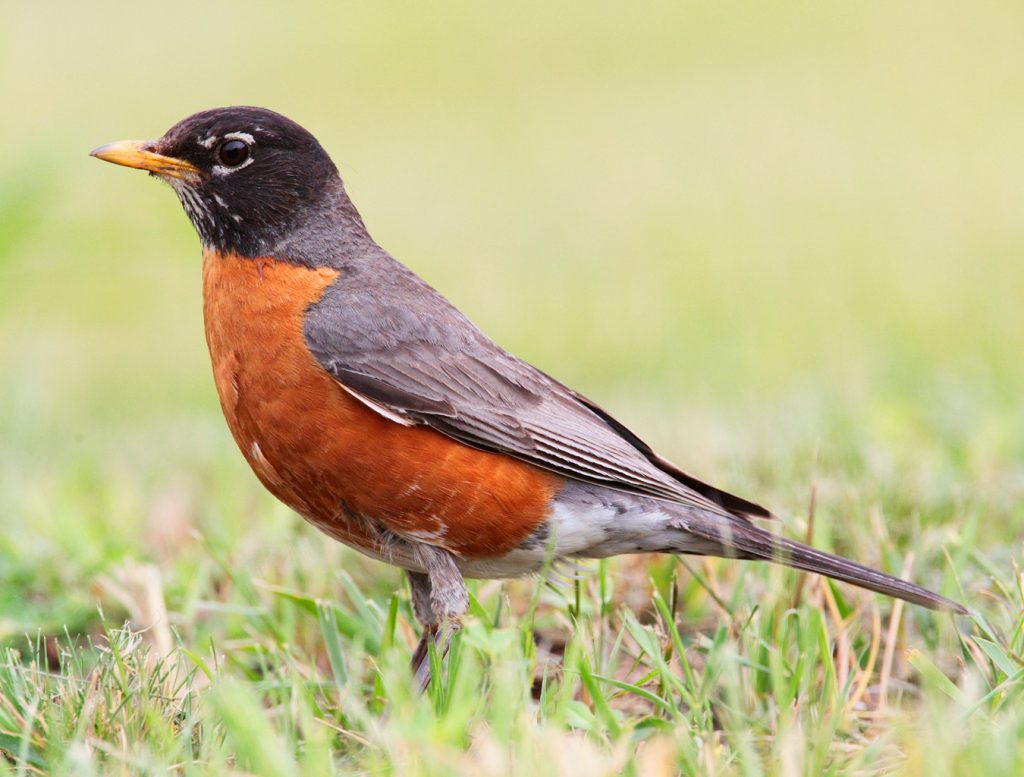
Coloration and Markings: The American Robin is beautiful and easy to identify. On the upper half of their body they have gray-brown wings and a long tail, with some white edging, while their breast and underbelly are a lovely orange color, though at the rump you will notice that the plumage becomes white and this continues to the bottoms of the tailfeathers. Facially, this bird is a darker gray-brown with some white outlining around the eyes and a short, slightly curved yellow bill.
Size: This bird measures in at 7.9 – 11 inches in length with a wingspan of 12.2 to 15.8 inches.
Habitat: When these birds aren’t in the woods they aren’t shy about visiting settled areas, spotted often in pastures, parks, golf courses, and backyards everywhere.
Diet: The American Robin loves fruit and insects. Try some dried mealworms, raisins, fruit seeds, and broken peanuts to really get and keep their attention.
Downy Woodpecker – Picoides pubescens
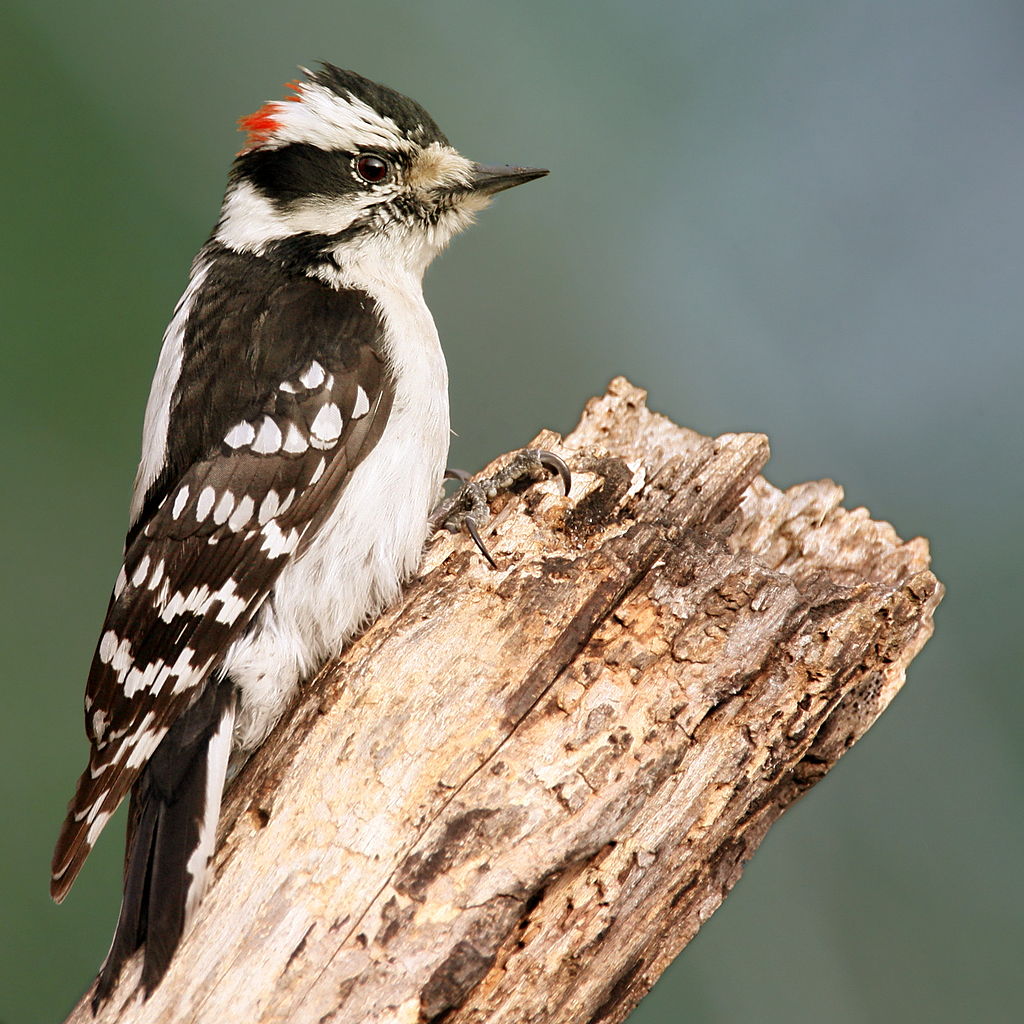
Coloration and Markings: Downy Woodpeckers are adorable and easy to identify. They have white backs with black wings and these wings have white ‘block’ patterns which move across them everywhere but the shoulder area. This gives them a look like a mix between a Zebra and a checkers board that you’ll recognize on sight. Their tails are short and black on top but white underneath and this bird has a snow-white underbelly and breast. Facially, you’ll notice that the white from the breast continues up to just under this bird’s short, black bill, where it terminates at a black ‘mustache’ line. Above the mustache, the bird is white until you get to it’s black mask-band, where the plumage becomes white again. Finally, tthis bird has a black cap and with males there is a red mark at the back of the head.
Size: This bird measures in at 5.5 – 6.7 inches with a wingspan of 9.8 to 11.8 inches.
Habitat: When not in the deep woods, these little guys will sometimes forage on the ground in dense brush or high weeds. They do love backyard feeders so be prepared.
Diet: The Downy Woodpecker will be quite pleased if you load up your feeder with Black Oil Sunflower, Peanuts, and Suet.
Mourning Dove – Zenaida macroura
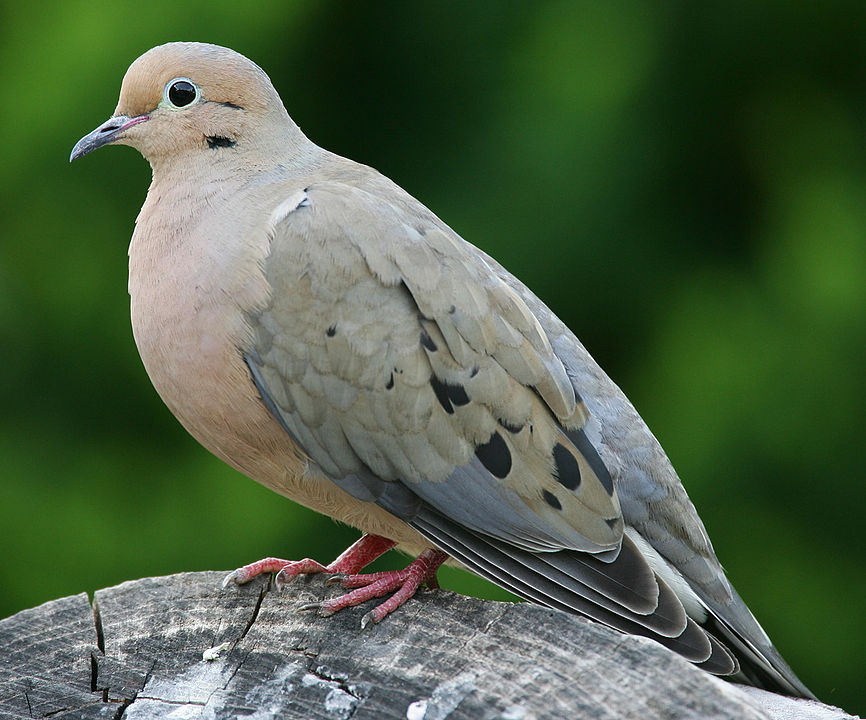
Coloration and Markings: The Mourning Dove’s appearance can vary a bit depending on the region, but most commonly you want to look for a Dove that is gray and tan all over, with come black spots on the wings and a little white outlining on the feathers of its long tail. The breast and belly will be lighter, almost completely tan, and facially the entire head is tan with the exception of a distinctive white outline over the eye. This bird has a short, straight black bill.
Size: These birds measure in at 9.1 – 13.4 inches in length and have wingspans of approximately 17.7 inches.
Habitat: These birds are little citizens, eschewing the forest for human habitations. Watch for them on telephone poles, fields, and certainly in your garden.
Diet: Millet, cracked corn, wheat, and Black Oil sunflower seeds are all enjoyed by the Mourning Dove.
Pennsylvania’s Birds of Spring, Summer, and Early Fall
With spring starting around late March the Pennsylvania wilds and your own home garden really start to show off. With this beauty come the birds of spring, summer, and early fall, ready to enjoy Pennsylvania’s bounty (especially the one in your backyard feeder!). Some birds you can keep an eye out for during these seasons are as follows:
- Gray-cheeked Thrush
- Blackpoll Warbler
- Cedar Waxwing
- Wood Thrush
- Northern Flicker
Gray-cheeked Thrush – Catharus minimus
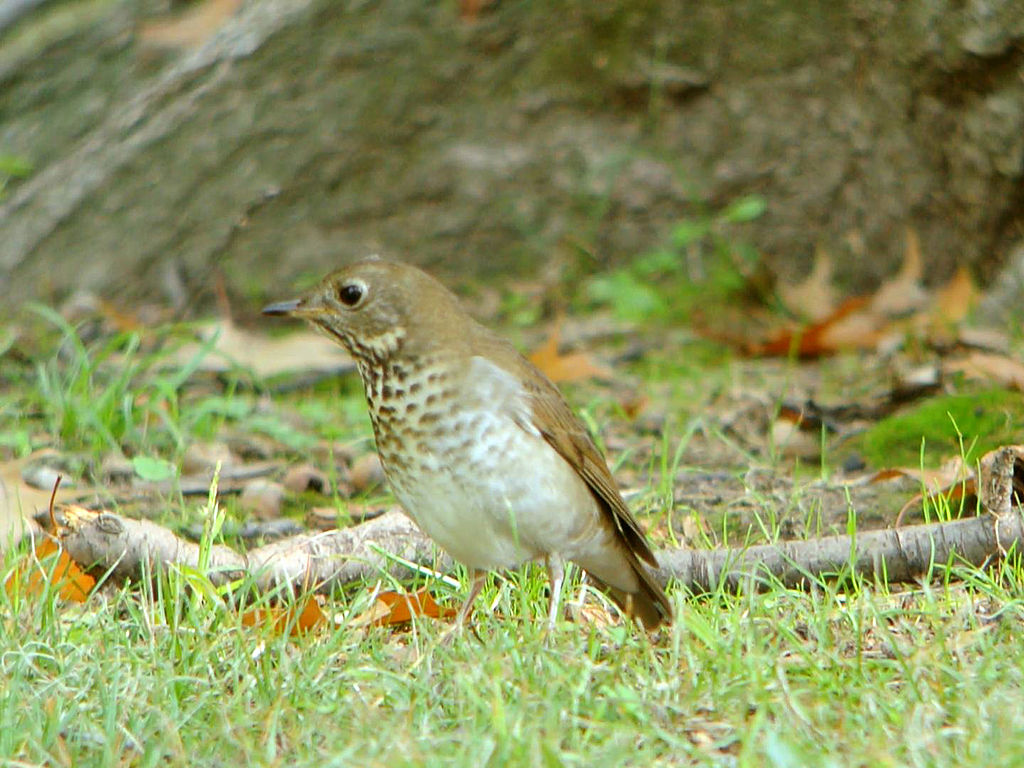
Coloration and Markings: The Gray-cheekeded Thrush is mostly brown or gray on top, with long wings and a short tail. The upper part of the breast is usually gray and tan with spots while the remainder of the breast and underbelly are a smooth gray. At the throat you will notice that the spots make lines until framing the cheek, where the bird’s face takes the color of the rest of its body. This bird has a short, sharp yellow bill.
Size: This bird is approximately 6.7 inches in length with a wingspan of approximately 12.6 to 13.4 inches.
Habitat: This is one of the ones to look for. These shy little birds hide out in dense vegetation either deep in the woods or at their edge.
Diet: This bird eats insects in the wild, so mealworms are a good idea, and if you have some shrubsandfruit vines in your garden then this might tempt a Gray-cheeked Thrush to visit.
Blackpoll Warbler – Setophaga striata

Coloration and Markings: Blackpoll Warblers have black and white streaked back and tail and the upper portion of their wings has the same pattern, with the lower portion of the wing being brown. The breast and underbelly are white, but flanked with this same pattern of vertical streaking. Facially, this bird is mostly black and white, with black at the top of the head and the white beginning just under the eye and continuing down to a black mustaches line. This bird has a long, slightly curved yellow bill. In the summer these birds have the same markings but they will be a greenish-yellow color.
Size: These birds measure in at approximately 5.5 inches in length and have wingspans of 8.3 to 9.1 inches.
Habitat: These birds love Evergreens and deciduous forests but may well venture into your feeder if you are lucky and well-prepared.
Diet: Dried mealworms, suet, and assorted berries are a good idea. If you have some berry vines in your yard then this increases your chances as well.
Cedar Waxwing – Bombycilla cedrorum
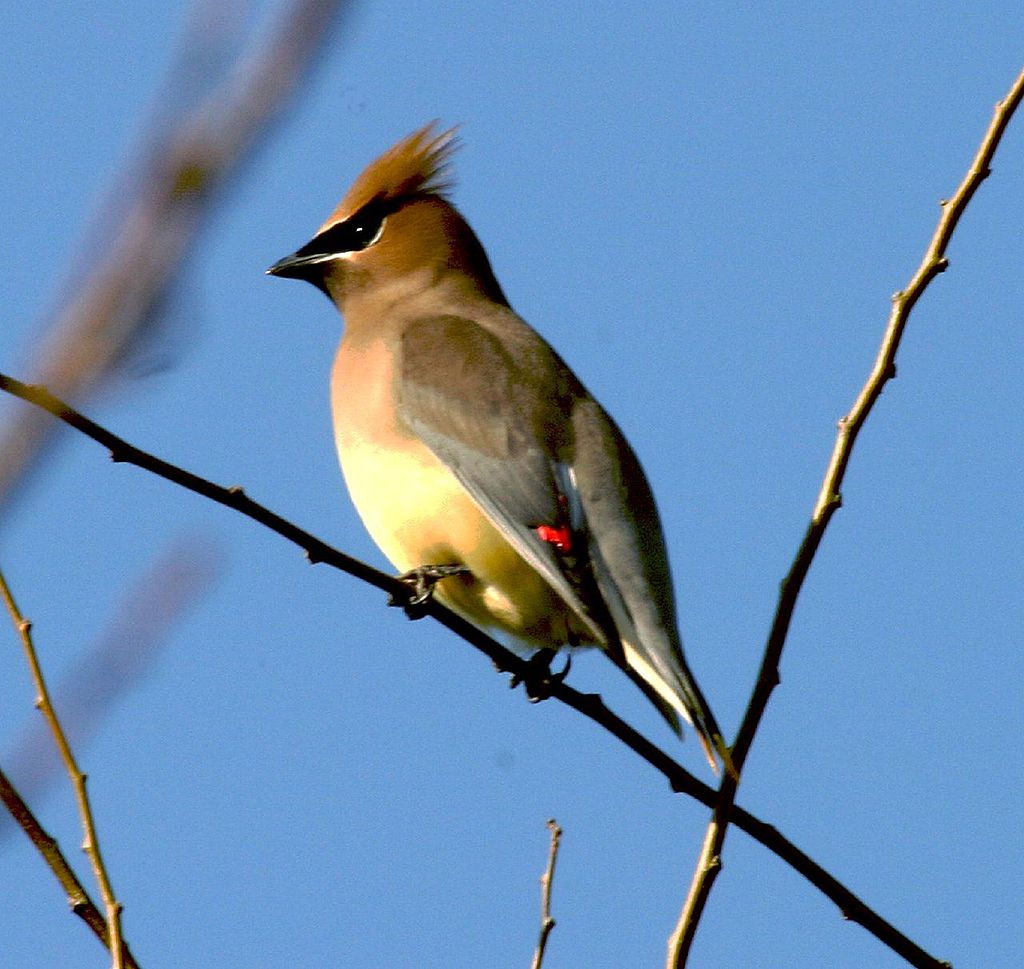
Coloration and Markings: The Cedar Waxwing has gray wings with some tan showing in the shoulder areas and short, gray tails with a yellow tip. The underbelly has some yellow which whitens at the rump and their breast is tan with a distinctive brown pattern that extends from the face, almost like a beard. Facially, this bird is soft brown and has a prominent crest, as well as a black mask which is outlined towards the bill with white and which curves upwards, as if separating the creat. These birds have short and stout, slightly curved black bills.
Size: These birds measure in at 5.5 – 6.7 inches in length with wingspans of 8.7 to 11.8 inches.
Habitat: When these birds aren’t in the woods they are almost certainly visiting orchards and gardens. They are not shy of human habitation (as long as fruit is involved).
Diet: If you don’t have a garden (or are only growing vegetables in it) then some chopped or small fruit placed out in an open area may attract these birds.
Wood Thrush – Hylocichla mustelina

Coloration and Markings: The Wood Thrush has reddish brown wings and tail with some white edging present. The breast of this bird is white with black spots with the spots lessening as they approach the white underbelly. Facially, this bird has a white-spotted chin, with the face being a mix of gray lines on white and a reddish-brown cap. A thin white outline is present around the eyes and this bird has a medium-sized black and yellow bill.
Size: These birds measure in at 7.5 – 8.3 inches with a wingspan of 11.8 to 13.4 inches.
Habitat: These birds prefer deciduous forests with very large trees but will occasionally venture forth (especially in winter).
Diet: While they are a little shy of feeders, one placed close to the ground and loaded with hulled Black Oil sunflower seeds has been known to tempt them from time to time.
Northern Flicker – Colaptes auratus
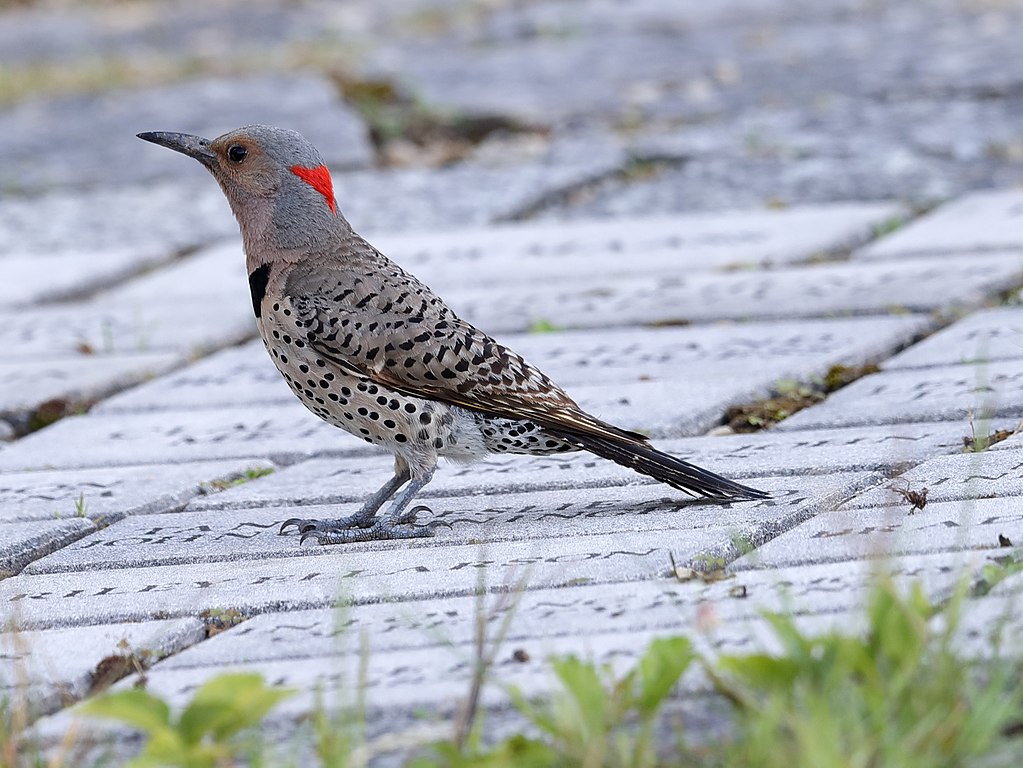
Coloration and Markings: These beautiful Woodpeckers are a brownish color overall with black spotting present on the back and the wings as well as on the breast and underbelly, The undersides of the wings and the tail will be orange or yellow and the upper breast often bears a distinctive black crescent. Facially, the Flicker is no less interesting, with a gray throat and a red streak above a black streak originating from the lower bill and a brown cap on the top of it’s head. The eyes have a thin white outline and this bird has a long, curved black bill.
Size: These birds are 11 – 12.2 inches from tip to tail and have wingspans averaging around 16.5 to 20 inches in length.
Habitat: These birds love open areas, such as the woodland’s edge, parks, and your backyard if it is capacious.
Diet: You can lure these birds to your feeder with peanuts, suet, Black Oil sunflower seeds, and assorted dried fruits.
Pennsylvania’s Fall and Winter Birds
With lows measuring in around 19 degrees Fahrenheit, Pennsylvania’s winters are not so harsh, but formidable enough for many birds to seek out somewhere warm to hide out. Not so for the birds below, who are more than happy to visit your feeder during wintertime for a fortifying snack. Watch out for these birds during the Pennsylvania fall through winter seasons:
- Black-capped Chickadee
- Hairy Woodpecker
- Dark-eyed Junco
- Purple Finch
- Northern Cardinal
Black-capped Chickadee – Poecile atricapillus
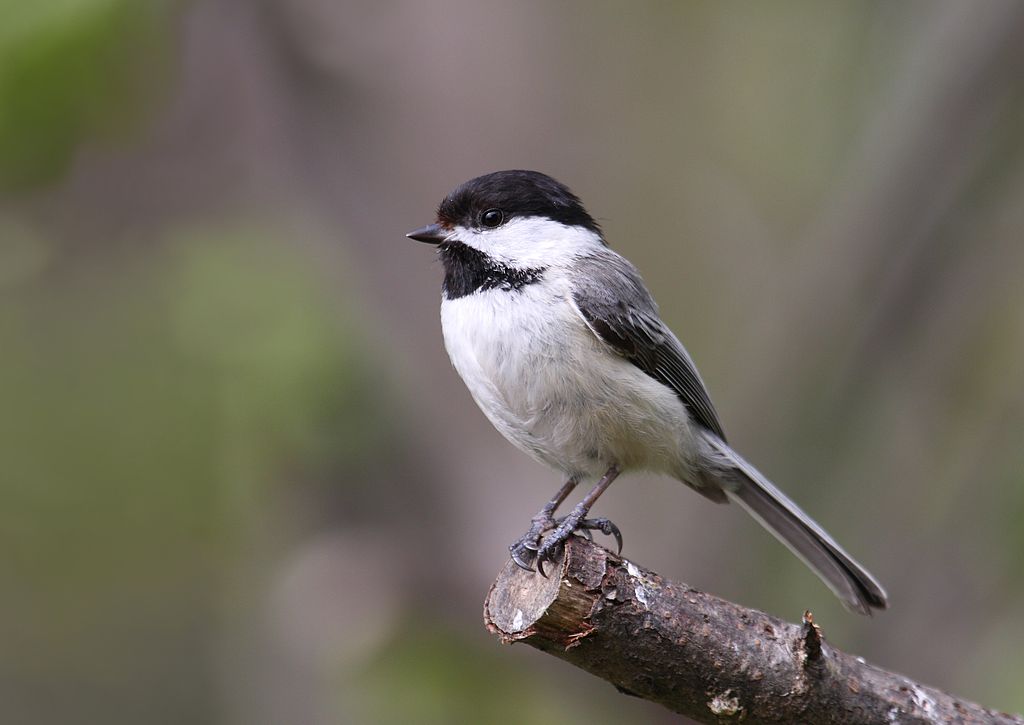
Coloration and Markings: The Black-capped Chickadee is beautiful and easy to identify. These birds have soft gray backs, wings, and tails with some white edging present in the wings. The breast and underbelly are snow-white and the faces are especially distinctive. Facially, the chin and throat are black, framing the cheek and center portion of the face, which are white. Finally, the black cap for which the bird is name begins at the top of the short, conical black bill and continues until just under the eye and to the back of the head, so that the upper portion is completely black.
Size: These little birds measure in at 4.7 – 5.9 inches in length and have wingspans of 6.3 to 8.3 inches.
Habitat: If there are trees or dense vegetation such as a thicket or shrubs then these birds may well be nearby. If you have a Birch tree then you might get extra lucky, as these birds like to nest in Birch and Alder trees.
Diet: Black Oil Sunflower seeds, suet, and peanuts are an easy way to attract and keep the attention of the Black-capped Chickadee.
Hairy Woodpecker – Dryobates villosus
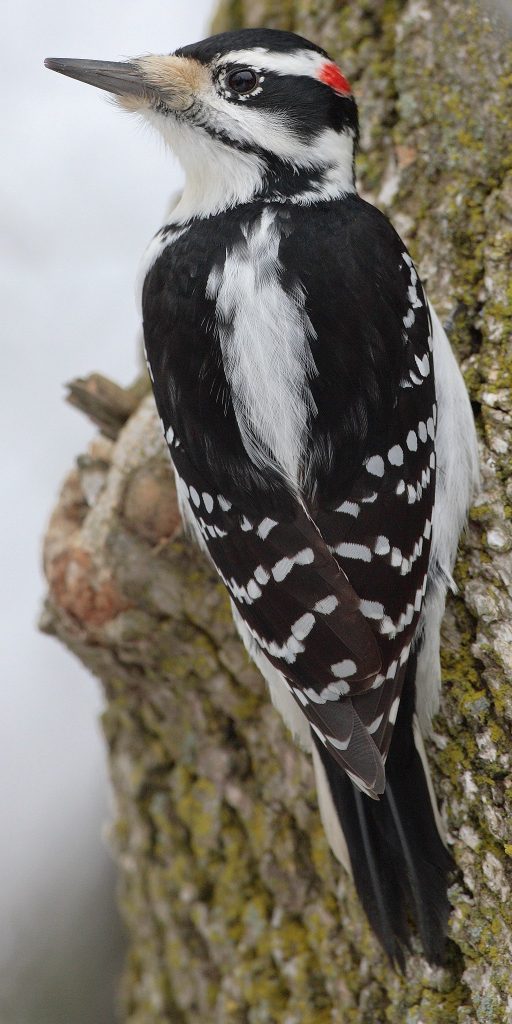
Coloration and Markings: Hairy Woodpeckers look quite similar to Downy Woodpeckers. They have a white back with black wings and white splotches creating a checker pattern. The breast and underbelly is completely white and facially these birds have white faces with a mustache mark, a black mask, and a black cap which terminates at the back of the head at a large reddish-orange spot (only on males). These birds have large, black bills that curve slightly upward.
Size: These birds measure in at 7.1 – 10.2 inches in length and have wingspans of 13 to 16 inches in length.
Habitat: These birds love the deep woods but they often venture to the forest’s edge as well as parks and suburban areas.
Diet: These birds love peanuts, suet, and Black Oil sunflower seeds. Stock up the feeder and watch them go!
Dark-eyed Junco – Junco hyemalis

Coloration and Markings: While there is some regional variance in their colorations, the Dark-eyed Junco is typically a dark gray or brown on the wings and tail. The upper breast has a saturation of this gray, which descends into a ‘flanking gray’ effect so that the lower portions of the bird are white as well as the undersides of the tailfeathers. The easiest way to visualize this is to remember that the lower 1/3 of this bird at rest is white while the rest is a solid dark gray or brown. Facially, this bird is the same gray/brown but has a distinctive, short-but-stout conical pink bill.
Size: Fairly small, these birds measure in at 5.5 – 6.3 inches from head to tail and have wingspans of approximately 7.1 to 9.8 inches.
Habitat: These birds prefer coniferous forests but they will visit parks, fields, and backyards when foraging.
Diet: Mostly insectivores, these birds do like the occasional berry, so put some assorted berries and other dried fruits in your feeder for best results.
Purple Finch – Haemorhous purpureus
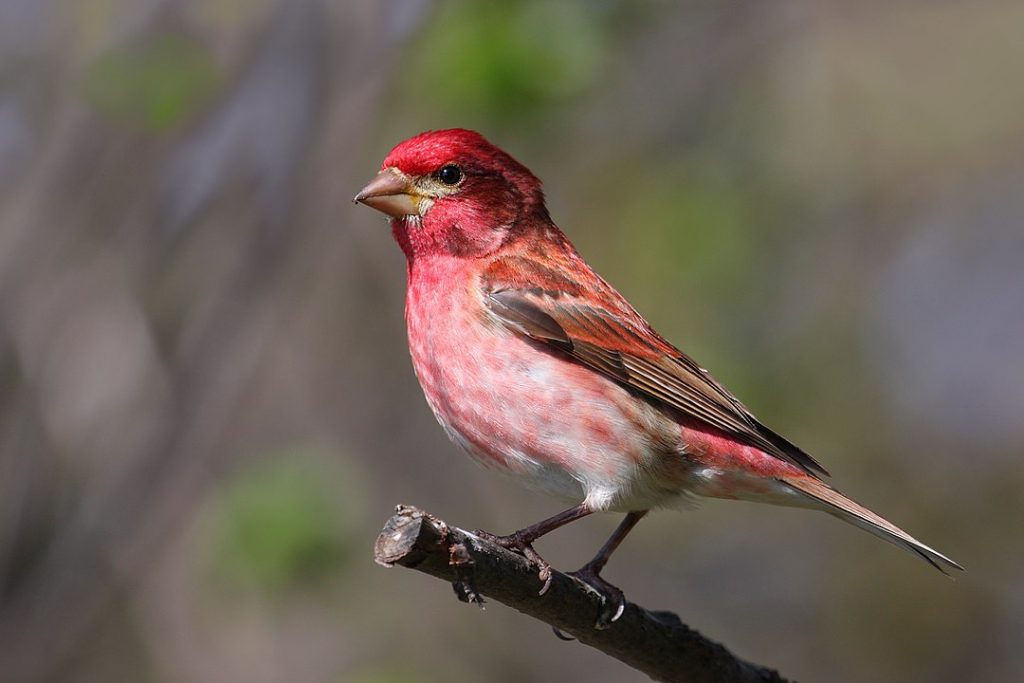
Coloration and Markings: The Purple Finch is one of the many examples of the male getting the nicest plumage. The wings are a mix of brown and pink which fades a bit as it gets to the medium-sized, animated tail. The breast and belly are white with splotches and streaks of raspberry and pink and facially, the male has a mostly pink face ith some exceptions. Typically a darker raspberry creates a mask, as well as a mustache line, and the top center of the head is this darker raspberry as well. These birds have medium-sized, stout bills which are typically gray with a black splotch on top occasionally present. Female Purple finches don’t actually get the raspberry-purple, but are rather brown with a prominent line on the throat and an off-white eyestripe.
Size: These pretty little chirpers measure in at 4.7 – 6.3 inches in length and have wingspans of 8.7 to 10.2 inches.
Habitat: These birds love both coniferous and deciduous woods but you can sometimes find them at the forest’s edge or areas with dense dhrubbery. They also are not too shy about backyards, provided there is a little bait waiting for them.
Diet: Our sources indicate that these birds seem to love Black Oil sunflower seeds the most, so it is easy to make these birds happy!
Northern Cardinal – Cardinalis cardinalis
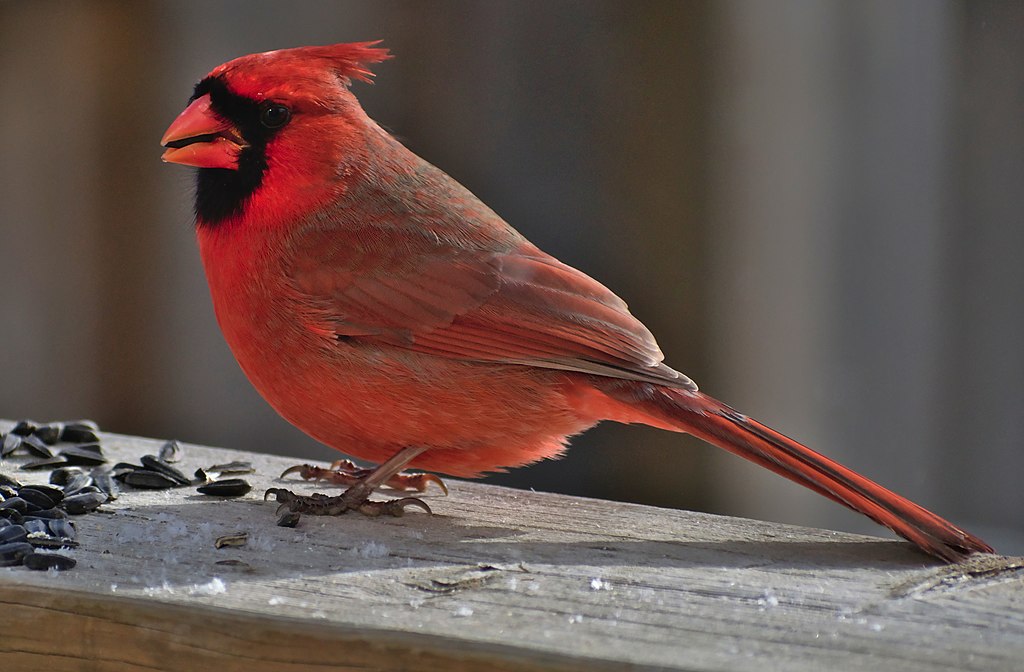
Coloration and Markings: It’s harder NOT to identify a spotted Cardinal than it is to identify one. These birds are a stunning red all over, with some black edging in the feathers of the wing and tail. They have black faces from the ‘mask’ mark and cheek coloration though the rest of the head is red, right up to this bird’s majestic crest. The females, by contrast, still have some excellent plumage, but they are a light brown with reddish tinges thrown in. Both male and female have stout, conical orange bills.
Size: Cardinals measure in at 8.3 – 9.3 inches with a wingspan of 9.8 to 12.2 inches in length.
Habitat: When these birds aren’t at the forest’s edge they readily travel through parks and urban areas. They are bold birds and happy to visit your feeder provided you’ve left a little something out for them.
Diet: These birds will eat just about anything… peanuts, suet, and millet are fine but they really seem to love Black Oil Sunflower seeds.
Supporting cast (Other Backyard Birds of Pennsylvania That Might Pay You a Visit)
Sometimes it feels like the odds are against you when you are patiently waiting for these Avian beauties to grace the backyard. To that effect, we’ve added 5 more birds that you can add to your checklist to look for as well as a little information on their diets and where they like to hide. This ‘Supporting Cast’ is by no means mundane, just an extra addition that we thought you might enjoy. Keep a lookout for these birds at any time of the year:
- Blue Jay
- American Goldfinch
- European Starling
- Gray Catbird
- House Finch
Blue Jay – Cyanocitta cristata
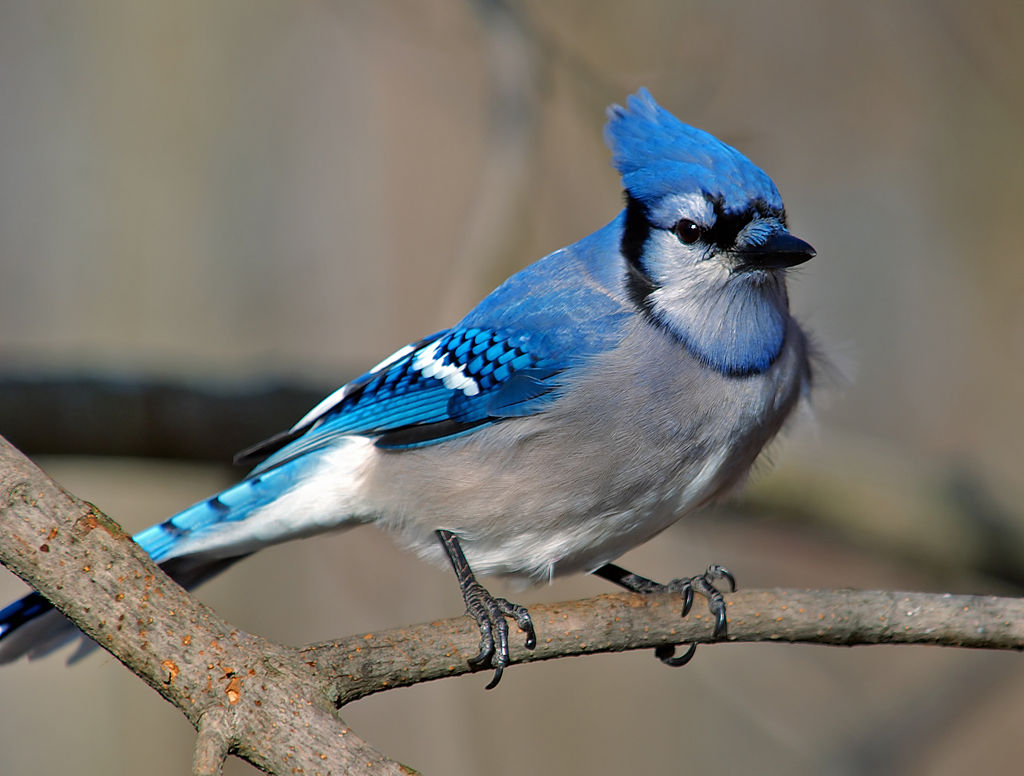
Coloration and Markings: Blue Jays are instantly recognizable, with blue backs and blue wings which are accented with white and black markings leading to a tail that is segmented into pale blue square patterns outlined in black. The breast and underbelly of this bird are white with some tinges of gray and facially, this bird has a black outline mark which travels from the lovely blue crest and around the throat to the other side, framing a white face with a long, straight black bill. Finally, this bird has a tiny mask that covers the eye in a delicate and abstract fasion, rather than the typical ‘banded line’ mask you might see in other birds.
Size: Roughly Robin-sized, these birds measure in at 9.8 – 11.8 inches in length and have wingspans of 13.4 to 16.9 inches.
Habitat: These birds love Oak trees and typically hang out at the the forest’s edge when they aren’t flitting about town. These birds are very urbanized and not shy, so be sure that feeder is ready for them. This is one bird you’ll never get tired of spotting.
Diet: You can tempt Blue Jays with suet, peanuts, and Black Oil Sunflower seeds.
American Goldfinch – Spinus tristis

Coloration and Markings: The American Goldfinch is beautiful and easy to identify. The males have bright yellow backs flanked by black wings that bear highly visible white wingbars and white vertical lines as you travel down the wings to the tail. They have a bright yellow breast and underbelly, though at the rump the coloration becomes white, and facially these birds have yellow faces with a small black cap from the forehead down to the conical orange bill. Females have olive caps and more subdued colors and in winter both birds go ‘incognito’, molting their bright plumage in lieu of a plain brown that doesn’t quite hide their distinctive wingbars.
Size: These birds measure in at 4.3 – 5.1 inches in length with a wingspan of 7.5 to 8.7 inches.
Habitat: These birds love fields and anywhere else where they might find some dense vegetation to forage and frolic in. They also like gardens, orchards, and backyards with stocked feeders.
Diet: The American Goldfinch is easy to please, just load your feeder with Nyjer and Black Oil Sunflower seeds.
European Starling – Sturnus vulgaris
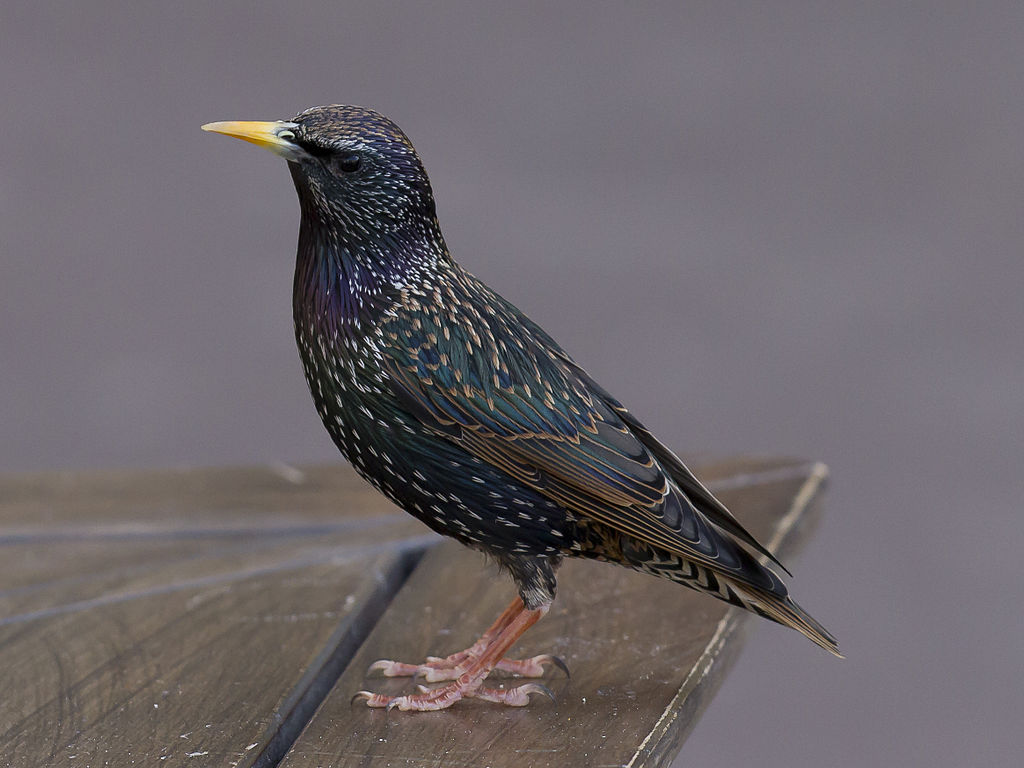
Coloration and Markings: These birds are easy to distinguish when they are close. The European Starling has brilliant green and purple plumage all over its body and a long, straight yellow bill. In the winter months they molt and change into plumage which is brown with bright white spots .
Size: Medium-sized, these birds measure in at 7.9 – 9.1 inches in length with wingspans averaging 12.2 to 15.8 inches.
Habitat: These are town and country birds, not shy at all about walking along the sidewalks as they forage for lunch. They like telephone poles especially so watch for them there next time you are in town.
Diet: European Starlings will eat just about anything but they are especially fond of grains. Try wheat and oats if you want to attract them without having to provide too diverse a selection. They’ll be more than happy with these 2 items.
Gray Catbird – Dumetella carolinensis

Coloration and Markings: The Gray Catbird goes with the ‘simple but elegant’ model of plumage coloration. These birds are entirely a soft gray with a few notable exceptions. First, the undersides of their tails are a rich orange-brown in the area close to the rump while the rest of the often-fanned, long tail is a dark gray to black. Facially, this bird has a gray face with half-mask stripe starting from the black, slightly curved bill and stopping just before the eye, and a a full black cap.
Size: These birds measure in at 8.3 – 9.4 inches from tip to tail and have wingspans of 8.7 to 11.8 inches.
Habitat: These birds love dense vegetation, such as shrubs, thickets, or anywhere with a lot of vines.
Diet: Gray Catbirds LOVE fruit, so if you don’t have a garden or fruit trees then you can appease them with offerings such as chopped apples, raisins, and dried apricots or other fruits.
House Finch – Haemorhous mexicanus
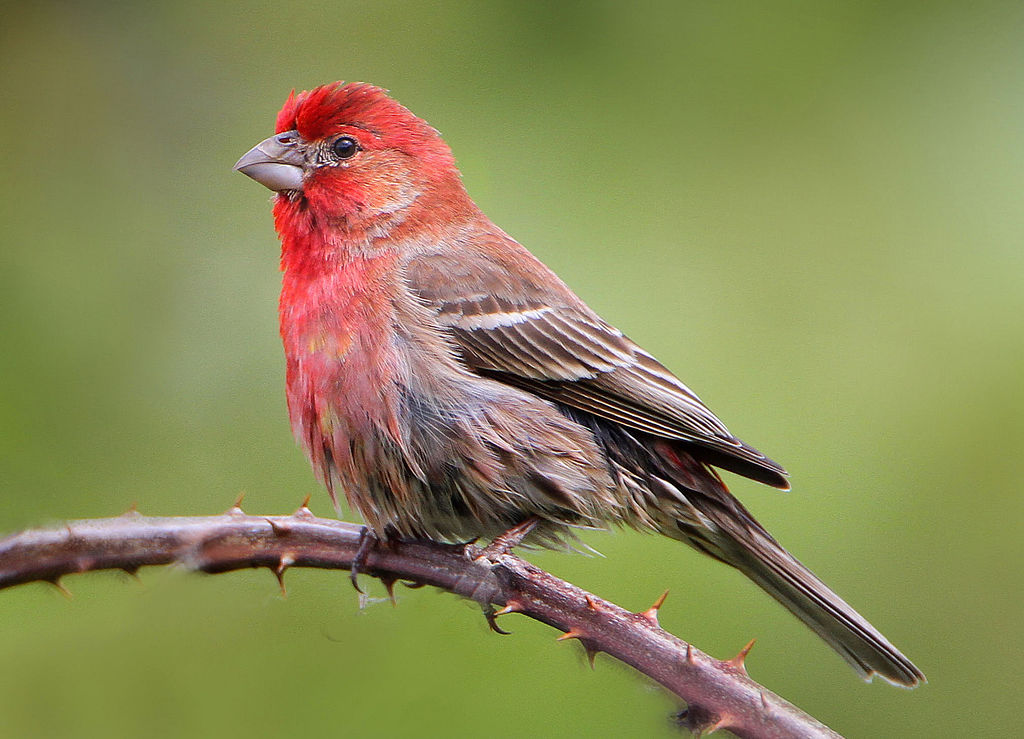
Coloration and Markings: Males are quite striking, with the male House Finch displaying dark gray or brown backs with dark streaks on the wings and tails as well. The lower portion of the breast and down to the underbelly is white and gray with rosy-red splotches which increase in density at the upper breast, which is almost completely rosy-red. This bird has a red rump as well but you can’t tell unless it is flying. Facially, the male has a mostly red face, with the exception being a very small mask of gray that zigzags from the eye, forking towards the back of the head and opposite to frame the cheek. This bird has a small, stout silver bill. Females are harder to identify if you haven’t seen one of the males, as they are gray and brown and lack the red of the males.
Size: These birds are 5.1 – 5.5 inches in length with wingspans of 7.9 to 9.8 inches in length.
Habitat: These urbanized little birds will play at the forest’s edge but more often than not they are flitting about farms, parks, and backyards.
Diet: House Finches love Black Oil Sunflower seeds, but go with the small variety or break them up a little to make it easier for the little guys.
Pennsylvania Bird Buffet
If you would like to attract the Avian feathered celebrities of Pennsylvania then the Pennsylvania Game Commission has a lovely article on the subject that you can check out here: https://www.pgc.pa.gov/Wildlife/Birding/Pages/BackyardBirdfeeding.aspx
We’ve taken some highlights that have matched our own data and will include them here so that you can sure that your feeder is ‘optimized’ for the birds which are most likely to visit. Be sure to stock your feeder with the following:
- Black Oil Sunflower
- Peanuts and/or peanut butter
- Cracked and ear corn
- White Proso millet
- Suet
Pennsylvania Birding Hot Spots
The Chirparazzi know all of the places in Pennsylvania where the feathered celebrity elite like to hide out. We’ve collected a few tips from them to share with you just in case you are looking to get out of the house or if you are not a Pennsylvania native. Check out one or more of the following locations to treat yourself to some choice sightings and photos:
- Northern hotspot – Susquehannock State Forest
- Eastern hotspot – Delaware Water Gap Hawk Lookout
- Southern hotspot – Gettysburg Battlefield
- Western hotspot – Moraine State Park
- Central hotspot – Bald Eagle State Park
Detailed descriptions of each location as well as information regarding visiting and what birds you can see at these locations may be found at https://www.pgc.pa.gov/Wildlife/Birding/Pages/BirdingLocations.aspx
In Conclusion
Today we have touched on the subject of the backyard birds of Pennsylvania and attempted to provide some information which might be of use for you in luring some beautiful birds to your own backyard. While no method is 100% effective, these tips can definitely help to raise your chances that one of these fickle feathered lovelies will notice your feeder and hopefully stick around for awhile. Just be patient and keep that feeder stocked and your eyes peeled. Those birds are just around the corner or hiding in the shrubs (they are sneaky that way) and they are waiting for you to coax them out. Happy birding, folks!
